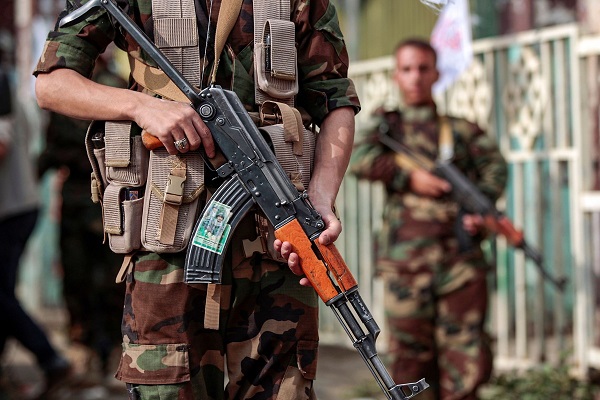If the genesis of the Houthis movement can be traced back to 1962, its impact on Yemen’s political order, and maybe more to the point &the role it has played in laying waste the Republic reached its most forceful velocity in 2011, when Arabia’s disenfranchised youth rose a tide against the proverbial ‘Establishment’. From the streets of Tunisia to the highlands of Yemen, few countries in the region have stood immune to the revolutionary fires of the Arab Spring. For Yemen, calls for regime change devolved into a brutal military confrontation which saw explode Yemen’s tentative socio-political fabric, thus putting the nation’s republican institutions under such strain its survival seems now all but unlikely. Yemen’s future therefore lies in its many actors’s ability and willingness to reinvent the state anew - the region’s future hinges on such a feat. To assume that Yemen’s disintegration can exist in isolation is but folly. And though the task of reversing Yemen’s descent into institutional oblivion and territorial disintegration will not prove easy, there can be no alternative. Much of Saudi Arabia’s national interests, notwithstanding the kingdom’s national security is tied to Yemen’s future - beyond that it is the Gulf region’s existing political iterations which stand in the balance. But can we claim to truly understands the nature of the Houthis movement - Ansarallah, when so much of what has been said remains tinted by political bias and a few layers of religious prejudices? Are we giving too much credence and traction to a movement which, while claiming to speak for the ‘people’ of Yemen by virtue of its armed resistance against a ‘foreign enemy’, has in actuality existed in an institutional vacuum devoid of any real popular legitimacy? Much of the Houthis’s powerbase stems from a lack of opposition to their governance. We should not understand the movement’s ability to rule as a clear popular mandate, but rather the expression of Yemen’s republican failure in promoting political pluralism. For a lack of alternative many Yemenis have felt compelled to support a movement they do not believe in, and does not represent their political aspirations. Since 2011, the Houthis were able to transform the power vacuum resulting from the Arab Spring upheavals into both a consolidation of their rule at home (Sa’ada Province) and an enormous territorial expansion throughout large parts of North Yemen. It was the group’s ability to tap into the frustration of Yemeni citizens over the slow pace of change, persistent corruption, and the poor economic and security situation on the back of the National Dialogue Conference (2014) which sealed Abdel Malek Al Houthi’s uncontested position as ‘leader’ of the disenfranchised. A populist ‘king’, Abdel Malek drew strength from the failure of the Republic, and its elite’s reluctance to admit political inadequacy before a people they were no longer connected to. Too often have we limited our analysis of the Houthis to that of a proxy of Iran - yet another satellite of Tehran by virtue of the group’s religious creed and its willingness to abide by some of Iran’s revolutionary adages: mainly its rejection of both the United States and Israel, the two powers Iran has defined itself against. The Houthi movement was born in reaction to a socio-political landscape which proved to be increasingly inhospitable to highlanders for a lack of economic integration, access to basic services: education and health, and acute political isolation by the hands of an elite for whom ‘power’ was a zero-sum game. Because Sana’a central government failed to integrate the highlands to the new republican schema, the highlands withdrew behind its traditions, seeking comfort in its past glory, for fear of losing all relevance - whether socio-economic and/or political. A report published by the Rand organisation, Regime and Periphery in Northern Yemen: The Houthi Phenomenon best expresses those complicated dynamics between the central government of Yemen and the Houthis, it reads: “At its base, the confrontation between the Houthi family and the Saleh regime is not a conflict among different tribal groupings. Likewise, at its origins, although the Houthi rebellion was inspired by Zaidi revival and led by charismatic Zaidi elites, it is not a confessional opposition movement challenging the legitimacy of the Government of Yemen - nor is it a local manifestation of the transnational ‘Shiite Crescent.’ Rather, it is a conflict in which local material discontent and Zaydi identity claims have intersected with the state center’s methods of rule and self-legitimation.” And: “As the conflict has proceeded, however, differences between the Houthis and the Government of Yemen have taken on the hues of both tribal and confessional strife, rendering a near-term resolution unlikely. Throughout, the Houthi family has been the spearhead of northern Yemeni opposition to the Saleh regime’s domestic and foreign policies. The Government of Yemen has thus sought to eliminate the family as an influence in Yemen and has targeted sympathetic individuals, groups, and institutions.” Where Yemen’s central government had to contend with relentless calls for secession in the South, it is ultimately the Highlands which precipitated the end of the Republic by directly challenging the relations the state &kept with its periphery - ie the various denominations of power in Northern Yemen.& In hindsight it appears evident that Yemen’s Arab Spring very much opened up the floodgate of revolutionary dissent, thus &leaving an already weakened Sana’a central government prime for an aggressive takeover.& Often dismissed by the ruling elite, for they lacked foreign patronage and religious clout, the Houthis were able to transmute from an initially Zaidi revivalist movement to a mass movement whose military agenda and organisational skills have been directed towards the creation of a new system of governance - that is not to say that the group managed to develop a clear political thought, quite the contrary.& The group’s enormous increase in importance and its expansionist impetus became particularly obvious during 2011 uprising and the ensuing National Dialogue Conference (NDC) which aimed to reform Yemen’s institutions to reflect its people’s hunger for change.& With the central government’s focus turned toward the capital, state authority in Sa’ada Province crumbled, allowing the Houthis to consolidate control over the administration of a province they had been contesting for over a decade. As the state grappled with the reality of its coming demise (2011), the Houthis left their ancestral ‘home’ to claim more territories to their nascent ideology &- one rooted in military militantism and religious populism.& Needless to say that such recipe proved devastating to the state and President Abdo Rabbo Mansour Hadi’s presidency. The man whose mandate was to transition Yemen to the Second Republic was largely interrupted by the ever-pressing demands of a movement which imagined itself of the people and for the people. To a great extent it is the Houthis’ political participation at the NDC which cemented the group’s political influence by gathering to its banner those the elite had shun. &Today the Houthis have de facto created a populist state which legitimacy is entrenched in a Zaidist version of political Islam. And though the group’s agenda may echo from a distance of Iran’s Islamic Revolution, its schema is in fact very different. Iran’s Revolution revolved around the principles of the Governance of the Jurist whereas Ansarallah wishes to establish a form of populist tribalism cemented around the military and the religious - a far-cry from the reforms promised and ratified by the NDC. In The Houthi Enigma: Ansar Allah and the ‘Second Republic’ Marieke Brandt writes: “The Houthis until now have made a poor job of defining what they stand for or how their approaches differ from &those of their contenders. The events of autumn 2014 rather &suggested that within their ranks various and even competing factions and currents were striving for influence behind the scenes. Whereas the Huthi envoys to the NDC represented the moderate and consensus-oriented spectrum of Houthism, the Politburo in Sa’ada was strongly influenced by hardliners. Despite the sophisticated and inclusive rhetoric of their supreme leader, the hardliners tended to &oppose reconciliation with their opponents and simultaneously spurred the group’s expansion by force.” By co-opting religion and fusing it with a narrow nationalism that constructs monolithic enemies, the Houthis have successfully risen themselves to the very height of power - to the tune of Yemen’s discontent. To dislodge the Houthis would require more than brutal force, especially if one considers that the group’s very existence is tethered to those principles of revolutionary resistance others in the region have exploited in order to expand, assert and affirm their reach. We would do well to heed Princeton Professor Jan-Werner Muller’s words on populism. “Populist governance exhibits three features: attempts to hijack the state apparatus, corruption and mass clientelism (trading material benefits or bureaucratic favours for political support by citizens who become populist ‘clients’), and efforts to systematically suppress civil society.”& One also needs to consider that the Houthis movement - Ansarallah, is not one but many, often contradictory, approaches. The group for example has demonstrated ad nauseam its willingness to use military force, coercion, and intimidation, while keeping to a political narrative that claims to support the establishment of a participatory state with a clear and unequivocal separation of power, as advocated in the NDC. This suggests that the Houthis are ¬ in fact a &uniform movement and thus still lack an ideological superstructure. Recent developments on the ground have come to validate such an affirmation, as the Ansarallah movement stands on the verge of a political split -each sub-group the expression of wildly contradictory political and religious agendas. The question today is not whether the Houthis will play a role in Yemen’s future, but rather what that role will be - integration, undoubtedly, will be the greatest test of Yemen’s Second Republic, one which will define much of Yemen’s future, both nationally and regionally. |
&






التعليقات